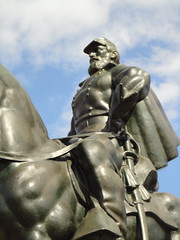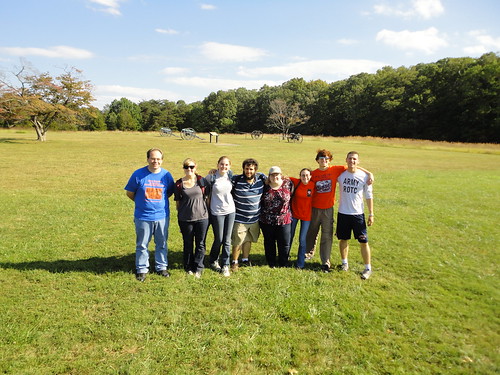 With an encouraging, “On to Richmond!” from Dr. Norman, we loaded the van at 7:30 a.m., headed for Manassas, Virginia. Our guide, Jim Burgess, met us at the Visitor Center and started our tour at Blackburn’s Ford where the first skirmish at Manassas took place. After a short stop and a quick look at the remains of the original road used by the Confederacy during the battle, we made our way to the famous Stone Bridge.
With an encouraging, “On to Richmond!” from Dr. Norman, we loaded the van at 7:30 a.m., headed for Manassas, Virginia. Our guide, Jim Burgess, met us at the Visitor Center and started our tour at Blackburn’s Ford where the first skirmish at Manassas took place. After a short stop and a quick look at the remains of the original road used by the Confederacy during the battle, we made our way to the famous Stone Bridge.
While most of the original bridge was destroyed in 1862 by the Confederates, the retaining wall of the bridge remains today. At that spot on July 21, 1861, Confederate Colonel Nathan “Shanks” Evans held his position against Tyler’s Union troops before learning of the attack on the unprotected Confederate left. Evans, the unsung hero of the battle, turned his forces and secured the left with a single brigade while facing the two divisions of Hunter and Heinztleman. Crossing the Stone Bridge gave us a sense of what types of obstacles faced the Union troops that morning.
 However, my favorite moment of the tour came after lunch as we trekked through the woods to Sudley Springs Ford where Heintzleman and Hunter crossed into Confederate territory. At this point in the tour, Burgess allowed us to cross the ford just as the Union soldiers had done in 1862. Four of us eagerly made the attempt, envisioning the challenges of crossing the ford weighed down by military gear and weaponry. We then proceeded down the creek bed to continue the historical experience.
However, my favorite moment of the tour came after lunch as we trekked through the woods to Sudley Springs Ford where Heintzleman and Hunter crossed into Confederate territory. At this point in the tour, Burgess allowed us to cross the ford just as the Union soldiers had done in 1862. Four of us eagerly made the attempt, envisioning the challenges of crossing the ford weighed down by military gear and weaponry. We then proceeded down the creek bed to continue the historical experience.
As we toured, Burgess retold several stories associated with the battle. Two stories in particular resonated throughout the rest of the day. The first concerned the fate of Major Sullivan Ballou, whose letter to his wife Sarah was made famous by Ken Burns’ Civil War documentary. Ballou was killed in action at Manassas and buried near the battlefield. Nearly a year later, Ballou’s grave was exhumed by Georgians who then burned Ballou’s remains in revenge for the losses they had suffered at the hands of the Rhode Islanders during First Manassas. This vindictive desecration left a sick feeling in my stomach as I remembered the loving words Ballou had written to his wife only a week prior to his death. The anecdote served to impress upon us the horrors and atrocities that emanated from the war, a reminder of the terrible powers of human beings to inflict pain on one another.
However, the day also contained stories of hope within the midst of war’s hell. We trudged past a pile of rocks that marked the former spot of the Benson family home on Christian Hill. During the battle, the Bensons found it their Christian duty to assist the wounded Union soldiers down the hill from their home, despite the fact that they themselves were loyal to the Confederacy. While giving aid, they found Union soldier James Rice who had been left for dead. The Bensons took the soldier to their own home and nursed him back to health. After the war, Rice returned to the Benson home, offering to repay their kindness through a monetary gift. The Bensons refused, claiming they had only done their duty. At Rice’s insistence, the Bensons relented by telling Rice that their church needed to be rebuilt and the congregation didn’t yet have the $1,000 necessary for the endeavor. Rice then went to his home state of Massachusetts and through a tireless effort raised over $1,100 for the Benson’s church. This story, when set next to the tragic Ballou incident, revealed that while some of the most deplorable aspects of human nature can come to the surface during war, the noblest aspects can also find space to grow.
 The day ended on Henry Hill where the final phase of the battle was fought in the late afternoon on July 21. Today, a monument to Thomas “Stonewall” Jackson presides over the field. The monument itself does not resemble the ragged, thin General Jackson, but rather a steroid addicted Herculean figure upon an overly muscled horse. The monument is a prime example of the way memory has influenced the preservation of the Civil War. Today, Jackson is seen as an almost god-like hero to be worshipped, instead of the eccentric VMI professor who inspired hatred among his own students. It was a fascinating end to an interesting day.
The day ended on Henry Hill where the final phase of the battle was fought in the late afternoon on July 21. Today, a monument to Thomas “Stonewall” Jackson presides over the field. The monument itself does not resemble the ragged, thin General Jackson, but rather a steroid addicted Herculean figure upon an overly muscled horse. The monument is a prime example of the way memory has influenced the preservation of the Civil War. Today, Jackson is seen as an almost god-like hero to be worshipped, instead of the eccentric VMI professor who inspired hatred among his own students. It was a fascinating end to an interesting day.
We drove back to the Appleford that evening feeling as though we had just taken the first step in an incredible journey to follow the path of the Civil War that tore our nation apart. We will continue our journey next week to the battlefield that saw the bloodiest single day in American history: Antietam, Maryland.

No comments:
Post a Comment